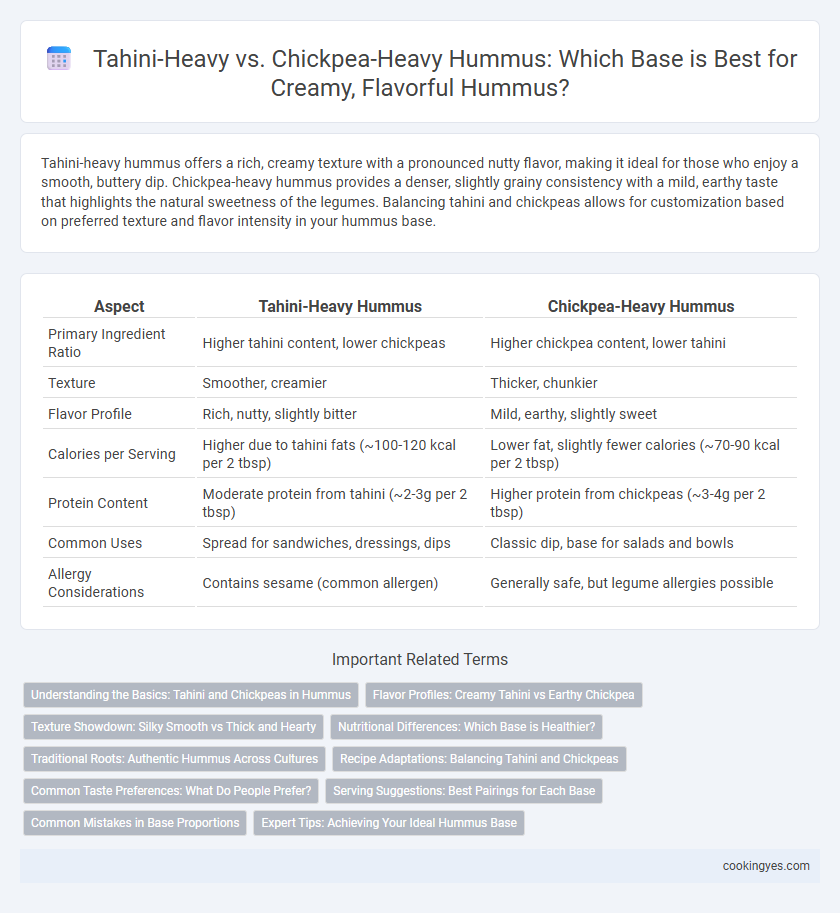Tahini-heavy hummus offers a rich, creamy texture with a pronounced nutty flavor, making it ideal for those who enjoy a smooth, buttery dip. Chickpea-heavy hummus provides a denser, slightly grainy consistency with a mild, earthy taste that highlights the natural sweetness of the legumes. Balancing tahini and chickpeas allows for customization based on preferred texture and flavor intensity in your hummus base.
Table of Comparison
| Aspect | Tahini-Heavy Hummus | Chickpea-Heavy Hummus |
|---|---|---|
| Primary Ingredient Ratio | Higher tahini content, lower chickpeas | Higher chickpea content, lower tahini |
| Texture | Smoother, creamier | Thicker, chunkier |
| Flavor Profile | Rich, nutty, slightly bitter | Mild, earthy, slightly sweet |
| Calories per Serving | Higher due to tahini fats (~100-120 kcal per 2 tbsp) | Lower fat, slightly fewer calories (~70-90 kcal per 2 tbsp) |
| Protein Content | Moderate protein from tahini (~2-3g per 2 tbsp) | Higher protein from chickpeas (~3-4g per 2 tbsp) |
| Common Uses | Spread for sandwiches, dressings, dips | Classic dip, base for salads and bowls |
| Allergy Considerations | Contains sesame (common allergen) | Generally safe, but legume allergies possible |
Understanding the Basics: Tahini and Chickpeas in Hummus
Tahini-heavy hummus features a rich, creamy texture with a pronounced nutty flavor derived from ground sesame seeds, while chickpea-heavy hummus offers a denser, earthier profile centered on cooked garbanzo beans. The balance between tahini and chickpeas influences both the consistency and nutritional content, with tahini providing healthy fats and chickpeas contributing plant-based protein and fiber. Understanding the interplay of these ingredients allows for customization of hummus to suit taste preferences and dietary needs.
Flavor Profiles: Creamy Tahini vs Earthy Chickpea
Tahini-heavy hummus offers a rich, nutty flavor with a smooth, creamy texture that enhances the sesame seed's natural oils, creating a luxurious mouthfeel. Chickpea-heavy hummus emphasizes earthy, slightly sweet notes with a denser, grainier consistency that highlights the legume's natural starch and protein content. Balancing these bases affects flavor complexity and texture, catering to preferences for either a silky indulgence or a hearty, rustic dip.
Texture Showdown: Silky Smooth vs Thick and Hearty
Tahini-heavy hummus offers a silky smooth texture with a rich, nutty flavor, creating a creamy consistency that spreads effortlessly. Chickpea-heavy hummus results in a thick and hearty base, delivering a more robust bite and grainy mouthfeel that highlights the legume's natural earthiness. Texture plays a crucial role in hummus preference, balancing velvety fluidity against dense substance for varying culinary uses.
Nutritional Differences: Which Base is Healthier?
Tahini-heavy hummus contains higher levels of healthy fats, calcium, and vitamin E due to its sesame seed base, supporting heart health and bone strength. Chickpea-heavy hummus offers increased dietary fiber, protein, and folate, promoting digestion, muscle maintenance, and cell function. Choosing the healthier base depends on nutritional goals: tahini-rich for essential fats and micronutrients, chickpea-rich for fiber and protein density.
Traditional Roots: Authentic Hummus Across Cultures
Traditional hummus recipes across the Levant emphasize a balanced blend of tahini and chickpeas, with some regions favoring a tahini-heavy base for a richer, creamier texture, such as in Lebanese and Palestinian variations. Chickpea-heavy hummus, often found in Israeli and some Mediterranean preparations, highlights the nutty, dense quality of chickpeas, offering a thicker, more robust consistency. This cultural diversity in hummus bases reflects centuries of culinary heritage, where tahini's sesame richness and chickpeas' hearty earthiness combine to create authentic flavors deeply rooted in Middle Eastern cuisine.
Recipe Adaptations: Balancing Tahini and Chickpeas
Hummus recipes vary significantly depending on the ratio of tahini to chickpeas, affecting texture and flavor intensity. Chickpea-heavy hummus offers a thicker, earthier base ideal for subtle tahini additions, enhancing creaminess without overpowering the legume's natural taste. Adjusting the balance allows customization of richness and smoothness, catering to diverse preferences in Mediterranean cuisine.
Common Taste Preferences: What Do People Prefer?
Hummus with a tahini-heavy base tends to offer a rich, creamy texture and a pronounced nutty flavor favored by those who enjoy bold, savory tastes. Chickpea-heavy hummus delivers a milder, earthier profile with a thicker consistency, appealing to individuals who prefer a subtle and hearty dip. Consumer taste preferences vary regionally, with Mediterranean palettes often preferring tahini-rich blends, while Western markets show a higher demand for chickpea-forward hummus due to perceived natural and wholesome qualities.
Serving Suggestions: Best Pairings for Each Base
Tahini-heavy hummus offers a rich, nutty flavor that pairs exceptionally well with fresh vegetables like cucumbers and carrots, as well as warm pita bread, enhancing Mediterranean mezze platters. Chickpea-heavy hummus provides a thicker, earthier texture ideal for spreading on sandwiches or serving alongside grilled meats, complementing bold, smoky flavors. For an elevated experience, drizzle olive oil and sprinkle za'atar over tahini-rich hummus, while a dusting of smoked paprika brightens chickpea-dense varieties.
Common Mistakes in Base Proportions
Using a tahini-heavy base in hummus often results in an overpowering bitterness and a thick, pasty texture that masks the natural sweetness of chickpeas. Overemphasizing chickpeas can lead to a dry, crumbly consistency lacking the creamy richness that balanced tahini provides. Optimal hummus base proportions typically involve blending roughly equal parts of tahini and chickpeas to achieve a smooth, flavorful spread with the ideal balance of nuttiness and earthiness.
Expert Tips: Achieving Your Ideal Hummus Base
Balancing tahini-heavy and chickpea-heavy bases is crucial for mastering hummus texture and flavor. Experts recommend starting with well-cooked, creamy chickpeas for a smooth foundation, then gradually incorporating tahini to enhance richness and tanginess without overpowering the chickpeas. Adjusting ratios based on desired creaminess and taste intensity ensures optimal hummus suited to individual preferences.
Tahini-heavy vs Chickpea-heavy for Hummus Base Infographic

 cookingyes.com
cookingyes.com